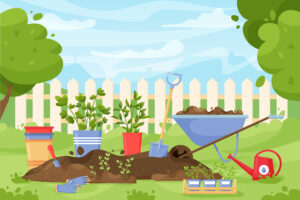
Building healthy soil forms the foundation for a productive and sustainable agricultural system. It supports plant growth by providing essential nutrients, helps retain moisture, and fosters a diverse microbial ecosystem crucial for decomposing organic matter and recycling nutrients. Moreover, healthy soil aids in combating climate change by sequestering carbon, thus playing a significant role in mitigating its effects. Without healthy soil, our capacity to produce enough food to meet the global demand is jeopardized, underscoring the need for practices that maintain and improve soil health for future generations.
Overview of the Process for Building Healthy Soil
Building healthy soil requires a multifaceted approach that encompasses adding organic matter, practicing crop rotation, implementing cover cropping, and minimizing soil disturbance. Organic matter, such as compost and manure, enriches the soil with nutrients and improves its structure, allowing it to better retain water and support diverse microbial life. Crop rotation helps to prevent soil depletion, reducing the risk of pest and disease buildup. Cover crops protect the soil from erosion and contribute to nutrient balance, while minimal tillage practices preserve the soil’s structure and the vital organisms within it. These strategies, when applied in harmony, create a self-sustaining ecosystem that supports vigorous plant growth and contributes to a more resilient agricultural landscape.
Understanding Soil Composition
Types of Soil
Soil composition varies greatly, encompassing several distinct types that differ in texture, structure, and nutrient content. The three primary types are sand, silt, and clay, each with unique qualities. Sandy soil is characterized by large particles and a gritty texture, promoting good drainage but often lacking in nutrient retention. Silt soil, with medium-sized particles, has a smooth texture and retains moisture better than sandy soil, making it more fertile. Clay soil comprises small, densely packed particles, holding nutrients well but posing challenges due to poor drainage and aeration. Often, the most productive soil is a well-balanced mix known as loam, which combines the positive attributes of sand, silt, and clay, providing a fertile and manageable medium for plant growth.
Organic Matter
The addition of organic matter is vital to nurturing healthy soil ecosystems. It serves as the cornerstone of soil fertility, acting as a sponge for moisture, a buffer for nutrients, and a foundation for the thriving communities of microorganisms that promote soil health. Organic material, like decayed plants and animal manure, decomposes to form humus, a nutrient-rich substance that enhances the soil’s ability to nurture plant life. This organic content not only supplies essential nutrients to plants but also improves the soil’s physical structure, making it more workable and better at retaining water and air, which are crucial for root growth and function. Without sufficient organic matter, soil becomes less able to support healthy plant growth, leading to weaker crops and an increased need for artificial fertilizers, which can be both costly and environmentally detrimental.
Soil Microorganisms
Microorganisms such as bacteria, fungi, protozoa, and nematodes are the unseen heroes within the soil ecosystem. They play a pivotal role in breaking down organic matter into nutrients that plants can easily absorb. Soil microbes also contribute to the formation of soil structure by creating aggregates—clusters of soil particles bound together—that improve the soil’s porosity and its ability to transport water and nutrients. Some soil bacteria and fungi form symbiotic relationships with plant roots, such as mycorrhizal fungi, which increase a plant’s reach for water and nutrients, while the plant provides the fungi with sugars for energy. Microorganisms are also involved in the nitrogen cycle, converting atmospheric nitrogen into forms that plants can use, an essential process for plant growth. Thus, the health of the soil microbiome is crucial for sustaining vibrant agricultural and natural ecosystems.
Steps to Building Healthy Soil
Step 1: Soil Testing
The first step in building healthy soil is to perform a soil test. Soil testing reveals vital information about the soil’s pH level, nutrient profile, and existing organic matter content. By understanding the soil’s current condition, you can make informed decisions about what amendments or corrections are necessary to improve its health and fertility.
Step 2: Choosing the Right Amendments
Based on the soil test results, the next step is to select the appropriate amendments. This may include adding lime to raise soil pH or sulfur to lower it, along with specific fertilizers to address nutrient deficiencies. The aim is to create a balanced environment where plants can thrive.
Step 3: Adding Organic Matter/Compost
Incorporating organic matter, such as compost, is critical for boosting the soil’s nutrient content and its ability to retain moisture and air. Compost improves soil structure, provides a slow-release of nutrients, and promotes a healthy microbiome, which all contribute to vigorous plant growth.
Step 4: Regular Aeration
Aeration involves perforating the soil to allow air, water, and nutrients to penetrate the root zone. Regular aeration helps to ease compaction, supports root growth and function, and facilitates the activity of soil microorganisms.
Step 5: Appropriate Watering
Lastly, implementing appropriate watering practices is essential for maintaining healthy soil. Overwatering can lead to waterlogging and root diseases, whereas insufficient watering can stress plants and degrade soil structure. It’s crucial to balance the frequency and volume of watering to the needs of the plants and the soil’s capacity to absorb and hold moisture.
Maintaining Healthy Soil
Soil Testing
Regular soil testing should be an integral part of your soil maintenance regimen. By periodically checking the soil’s pH levels and nutrient profile, you can detect changes over time and adjust your management practices accordingly. It’s recommended to test your soil every 1-2 years, or more frequently if you’re making significant changes to your soil management strategy. This proactive approach ensures that your soil remains fertile and responsive to your plants’ needs, leading to a more robust and productive garden or landscape.
Incorporating Crop Rotation
Crop rotation is an agricultural practice that involves growing different types of crops in the same area across a sequence of growing seasons. This strategy plays a pivotal role in maintaining healthy soil as it prevents the buildup of pathogens and pests that often occurs when one species of plant is continuously cultivated in the same location. Additionally, by alternating crops with varying nutrient demands, crop rotation helps in balancing the soil’s fertility. Legumes, for instance, can enrich the soil with nitrogen, benefiting subsequent plantings. Crop rotation also aids in reducing soil erosion and can improve soil structure and organic matter content, essential elements for a sustainable, productive garden.
The Benefits of Cover Crops
Cover crops serve as a crucial tool in sustainable soil management. These plants are sown to cover the soil rather than for the purpose of being harvested. Cover crops, such as clover, vetch, and rye, play a significant role in preventing soil erosion by shielding the soil from the impact of rain and wind. Moreover, they act as natural fertilizers by fixing nitrogen in the soil and add organic matter when they decompose, enhancing the soil’s structure and nutrient content. Furthermore, cover crops suppress weed growth, reducing the need for chemical herbicides, and provide a habitat for beneficial insects and microorganisms that contribute to a more bio-diverse ecosystem. Incorporating cover crops into your gardening strategy can lead to healthier soils and more vigorous, productive plants.
Smart Watering Strategies
Efficient watering practices are essential in sustainable garden management, maximizing plant health while conserving a precious resource. Implementing smart watering techniques, such as drip irrigation or soaker hoses, targets the water directly to the plant’s root zone, reducing evaporation and minimizing water waste. Collecting rainwater in barrels can provide an eco-friendly irrigation option, and mulching conserves moisture by preventing excess evaporation from the soil. Timing is also crucial; watering plants early in the morning or late in the evening reduces water lost to the midday sun and wind. By using these smart watering strategies, gardeners can ensure that every drop counts towards a thriving garden ecosystem.
Conclusion
Maintaining healthy soil is a cornerstone of sustainable gardening, critically affecting both plant health and the wider ecosystem. Soil is more than just a medium in which plants grow; it is a living system teeming with organisms that contribute to the bioavailability of nutrients. The use of cover crops and smart watering strategies is instrumental in protecting and enhancing this natural resource. Cover crops add vital organic matter and nutrients back into the soil, reduce erosion, and provide a habitat for beneficial organisms. Smart watering techniques ensure that the soil maintains adequate moisture levels without wasting water or promoting soil compaction. By prioritizing soil health, gardeners can cultivate a garden that is both productive and environmentally responsible.
As stewards of the land, gardeners hold the profound responsibility to nurture and protect the soil that sustains us. Embracing sustainable soil practices is not just an act of gardening; it’s a commitment to future generations and the health of our planet. Let’s continue to enrich our soils, conserve our water, and foster the biodiversity beneath our feet. Every effort counts, from urban container gardens to sprawling rural landscapes. Together, through education and action, we can promote a world where gardens flourish and ecosystems thrive.

